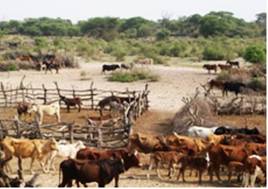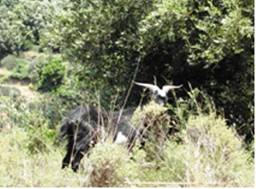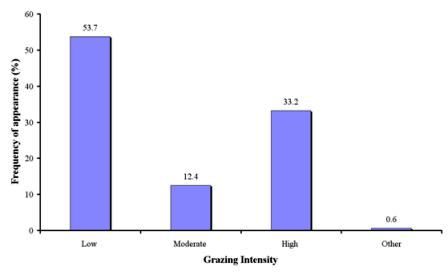Grazing intensity
It is a measure of the pressure imposed on the growing vegetation by the grazing animals. The number of animals is the main factor that affects the bioproductivity of the grazed lands. A standard way to express this impact is to calculate the stocking rate, namely the number of animal units per unit area during the grazing period. If the stocking rate in a grazing land is higher than its grazing capacity then overgrazing occurs (Fig. 67). An overgrazing land is vulnerable to desertification if the high number of animals remains for long period in the pasture and there is adverse soil, topographic and climatic conditions.


Fig. 67. Grazing land under high (left, Botswana) and low stocking rate (right, Crete) subjected to high and low desertification risk, respectively
The assessment of stocking rate has been assessed in this project by calculating the stocking rate (SR) and the grazing capacity (GC) and comparing these two values. If SR equals GC the rangelands are properly grazed, but if SR does not equal GC then grazing is improper and irrational and should be adjusted. The corresponding formulas for calculation are:
| SR= | |
| GC= |
one sheep equivalent (SE) = 1 sheep = 0,8 goats = 0,2 cattle. The following classes have been used: (a) low grazing intensity (SR<GR), (b) moderate grazing intensity (SR = GC to 1.5GC), and (c) high grazing intensity (SR>1.5GC).
As Table 9 shows, data for this indicator have been collected from 1141 field sites, corresponding to 14 study sites. The prevailing class of grazing intensity in the study field sites was low, that means the stocking rate was lower than the grazing capacity, covering 53.7% of the total fields (Fig. 67). Such grazing intensity was defined in all study fields of Novij Saratov-Russia, and Guadalentin Basin Murcia-Spain, and in some fields of Secano Interior-Chile, Mamora Sehoul-Morocco, Zeuss Koutine-Tunisia, Djanybek-Russia, Cointzio Catchment-Mexico, Gois-Portugal, and Crete-Greece. The next important class of grazing intensity was high, covering 33.2% of the study field sites, and corresponding to the study sites of Interior-Chile, Boteti Area-Botswana, Santiago Island-Cape Verde, Mamora Sehoul-Morocco, Zeuss Koutine-Tunisia, Djanybek-Russia, and Crete-Greece. Finally, moderate grazing intensity has been defined only in 12.4% of the total field sites, corresponding to the sites of Secano Interior-Chile, Gois-Portugal, Boteti Area-Botswana, Eskisehir-Turkey, Santiago Island-Cape Verde, Mamora Sehoul-Morocco, Zeuss Koutine-Tunisia, and Djanybek-Russia.

Fig. 68. Distribution of grazing intensity classes identified in the study field sites